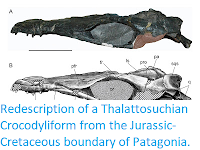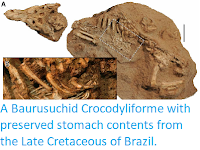The Metriorhynchids were Mesozoic Thalattosuchian Crocodylomorphs adapted to a fully
aquatic marine lifestyle. Their limbs were modified into paddle-like
flippers, they has a shark-like tail-fin and had lost the osteoderms in
their skin. Meriorhynchids appear to have been fully pelagic, i.e.
capable of swimming freely in ocean currents, rather than being
restricted to inshore environments. The Meriorhynchids appeared in the
Middle Jurassic and survived into the Early Cretaceous. The genus Cricosaurus currently contains nine species of Metriorhynchid Crocodylomorphs from the Late Jurassic and Early Cretaceous of Europe and North America, however cladistic analysis (computerised analysis of relationships within the
group based entirely upon shared common features rather than assumed
relationships) has suggested that two members of the genus, Cricosaurus saltillensis and Cricosaurus macrospondylus may be more closely related to other Metriorhynchids than they are to the other members of the genus.
In a paper published in the journal Acta Palaeontologica Polonica on 4 April 2019, Sven Sachs of the Naturkunde-Museum Bielefeld, Mark Young of the School of GeoSciences at the University of Edinburgh, Pascal Abel of the Senckenberg Centre for Human Evolution and Palaeoenvironment at Eberhard- Karls Universität Tübingen, and Heinrich Mallison of Palaeo3D, describe a new species of Cricosaurus from the Late Jurassic Torleite Formation of Wattendorf near Bamberg in Bavaria, southern Germany.
The late Kimmeridgian (roughly 155-152 million years old) Torleite Formation of the Franconian Jura comprises a series of Late Jurassic shallow-marine sediments, including numerous Sponge-Microbial reef structures and micritic lithographic limestones, the oldest examples of these highly fossiliferous deposits in southern Germany. The new specimen comes from the Wattendorf Member from a quarry near Bamburg, a course microtic limestone dated to the Aulacostephanus pseudomutabilis Ammonite Zone (about 153.96 to 153.55 million years old), a deposit that has produced numerous Plants, Invertebrates Fish, Rhynchocephalians, Turtles, Pterosaurs, and Thalattosuchians, which were preserved after settling on the floor of lagoons between the reefs, where dysoxic or anoxic conditions prevailed beneath an oxidated, plankton-rich upper water column, favouring the preservation of articulated skeletons in calcareous mud.
The new species is named Cricosaurus bambergensis, meaning 'from Bamburg'. It is described from a single specimen comprising an almost complete articulated skeleton preserved with the skull in ventral view and the body in lateral view.
The skull of the specimen is damaged, but the mandible and palate are well preserved, with sutures clearly visible. Twenty three teeth are visible on the right maxilla, with three teeth present on the premaxila; the dentary is less well preserved and the number of teeth unclear. The teeth are slender, labiolingually compressed (i.e. longer front-to-back than side-to-side), and elliptical in cross-section. A low-keeled carina (ridge) is present on the front and back edges of the teeth.
The specimen has seven cervical (neck), eighteen dorsal (back), and two sacral (lower back) vertebrae, with each of the dorsal and sacral vertebrae supporting a slender, slightly offset, rib. Within the rib cage parts of a gastralium (gastral basket) can be seen. The tail comprises fifty four vertebrae, twenty eight preflexural, six flexural (the bit where the tail bends) and twenty postflexural, though there is a break after the thirteenth vertebra.
See also...
The new species is named Cricosaurus bambergensis, meaning 'from Bamburg'. It is described from a single specimen comprising an almost complete articulated skeleton preserved with the skull in ventral view and the body in lateral view.
Metriorhynchid Thalattosuchian Cricosaurus bambergensis, late Kimmeridgian of Wattendorf (southern Germany). Skeleton in ventrolateral view. Sachs et al. (2019).
The skull of the specimen is damaged, but the mandible and palate are well preserved, with sutures clearly visible. Twenty three teeth are visible on the right maxilla, with three teeth present on the premaxila; the dentary is less well preserved and the number of teeth unclear. The teeth are slender, labiolingually compressed (i.e. longer front-to-back than side-to-side), and elliptical in cross-section. A low-keeled carina (ridge) is present on the front and back edges of the teeth.
Metriorhynchid Thalattosuchian Cricosaurus bambergensis, late Kimmeridgian of Wattendorf (southern Germany). (A) Dentition. (B) Palatines showing the midline keel seperating symmetrical depressions (dashed outline). (C) First cervical vertebrae. Abbreviations: aac, atlas-axis vertebrae; cv, cervical vertebra; hy, hyoid. Sachs et al. (2019).
The specimen has seven cervical (neck), eighteen dorsal (back), and two sacral (lower back) vertebrae, with each of the dorsal and sacral vertebrae supporting a slender, slightly offset, rib. Within the rib cage parts of a gastralium (gastral basket) can be seen. The tail comprises fifty four vertebrae, twenty eight preflexural, six flexural (the bit where the tail bends) and twenty postflexural, though there is a break after the thirteenth vertebra.
Metriorhynchid Thalattosuchian Cricosaurus bambergensis, late Kimmeridgian of Wattendorf (southern Germany). Distal part of the tail showing the flexural and postflexural region. Sachs et al. (2019).
See also...
Follow Sciency Thoughts on Facebook.









